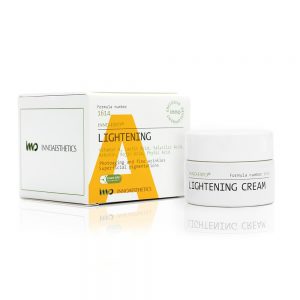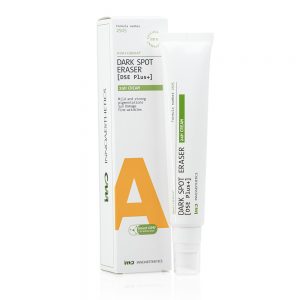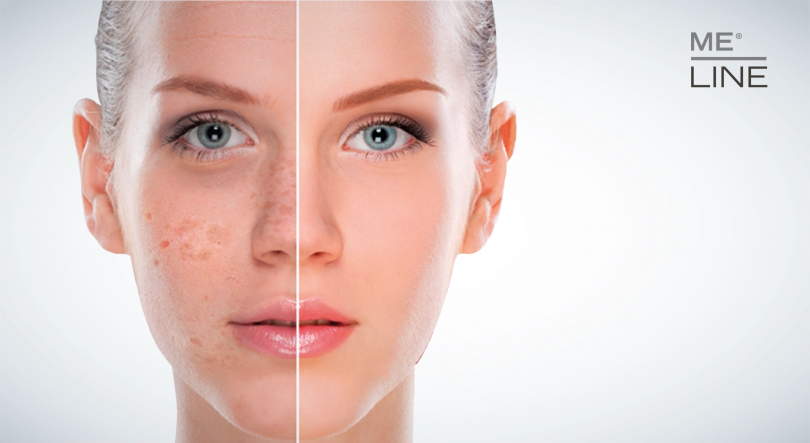Hyperpigmentations are harmless dark skin patches caused by a localized increase of melanin production. There are different types of hyperpigmentations and they can be triggered by different factors such as sun exposure, hormonal disorders or wound healing. Most of the population are affected or have been affected by this alteration at some point in their lifetime.
How Are Hyperpigmentations Formed?
Melanin are darkening pigments that determine the colour of our skin and protect our skin cells from UV radiation as they absorb UVA and UVB radiation.
This melanin is produced by Melanocytes (specialized melanin-producing skin cells located in the basal layer of our epidermis) during a complex process called Melanogenesis which is triggered by the Melanocyte-Stimulating Hormone (MSH). Tyrosinase enzyme (present in our skin) plays an important role in melanin synthesis or melanogenesis as the oxidation of this enzyme is, precisely, the first step of melanogenesis.
Once is formed, the melanin will be transported from the Melanocytes to the Keratinocytes (cells located in the outermost layer of the skin) by some organelles called Melanosomes.
In short, the increase of melanocytes or their stimulation results in the increase of melanin production.
The melanogenesis produces 2 types of melanin in human epidermis: a black/ brownish one called eumelanin and a reddish/yellow one called pheomelanin. The excess of eumelanin, even if mixed with the softer pheomelanin, can lead to the formation of hyperpigmentations in certain areas, and the percentages of eumelanin and pheomelanin will determine the colour of the blemish.
Dark skin phototypes are more prone to suffer hyperpigmentions as they can produce more melanin than fair phototypes.
Types of Hyperpigmentations and How To Treat Them
- Freckles or Ephelides
This is the most common type of hyperpigmentation. They are discrete brown spots that appear on the upper cheeks after sun exposure. This type of hyperpigmentation has a genetic predisposition and is very common in fair-skinned people. They become more prominent after sun exposure and attenuate when not exposed, so they do not normally require any treatment. However, we highly recommend using a good sunscreen to prevent them.
Freckles do not disappear completely, but they can be attenuated with depigmenting elements such as Dark Spot Eraser.

- Solar Lentigines, Sun Spots or Age Spots
UV-induced pigmented macules with a defined edge that can vary from light brown to black. Their severity depends on how much they have been exposed to solar radiation.
Their appearance can resemble to that of a malignant melanoma so, if in doubt, visit a specialist for an accurate diagnosis.
Solar lentigo can be completely removed thanks to MELINE Spots.
This treatment should always be prescribed, performed and supervised by your specialist or dermatologist.
- Melasma / Chloasma
Light to medium brown coloured diffuse large patches that appear normally in face. They can vary size and shape and have blurry edges. Women are more prone to suffer these pigmentations as they are normally triggered by hormonal changes, thus the use of oral contraceptives, pregnancy etc. are often the source. They worsen significantly with sun exposure.
MELINE’s recommendation for the treatment of Melasma is:
Caucasian Skin and Ethnic Skin, two different products for different skin phototypes. Their mechanisms effectively inhibit the oxidation of tyrosinase thus preventing melanin synthesis and reduce epidermal melanin deposits.
They also combine a professional product to be applied in the clinic with two other serums to be applied home, which are essential for the success of the treatment.
- PIH, Post-Inflammatory Hyperpigmentation
Hyperpigmentation that appears after injury or burn. People affected by inflammatory acne are very prone to suffer it. They present pink, reddish or brown colour.
Their formation is triggered by the natural skin healing process as inflammation in the epidermis stimulates melanocytes increasing the production of melanin.
Although it can disappear naturally it is always better to treat it and speed up its resolution.
Our proposal:



